Początkujący często pytają nas o przejście na SSL lub HTTPS. Terminy te mogą brzmieć zbyt technicznie, ale w rzeczywistości jest to bardzo proste.
HTTPS w adresie URL strony internetowej oznacza, że korzysta ona z bezpiecznego protokołu przesyłania danych poprzez zainstalowanie certyfikatu SSL. Jest to ważne, ponieważ większość nowoczesnych przeglądarek wyświetla ostrzeżenia dla witryn, które nie używają protokołu HTTPS.
Na szczęście większość niezawodnych firm hostingowych i WordPress bardzo ułatwiają zabezpieczenie witryny.
W tym artykule pokażemy, jak przenieść WordPress z HTTP na HTTPS poprzez dodanie certyfikatu SSL. Nie martw się, jeśli nie wiesz, czym jest SSL lub HTTPS. Wyjaśnimy to również.
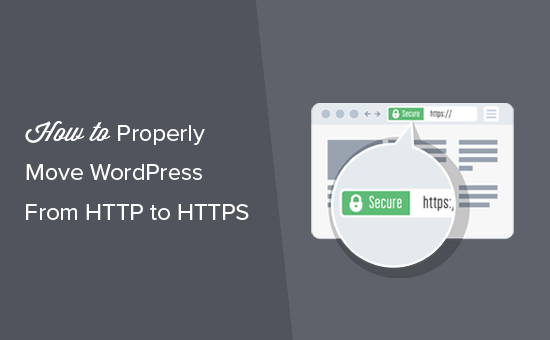
Oto krótki przegląd tematów, które omówimy w tym artykule:
- What Is HTTPS?
- Why Do You Need HTTPS and SSL?
- Requirements for Using HTTPS/SSL on a WordPress Site
- Setting Up WordPress to Use SSL and HTTPS
- Method 1: Setup SSL/HTTPS in WordPress Using a Plugin
- Method 2: Set Up SSL/HTTPS in WordPress Manually
- Submit Your HTTPS Site to Google Search Console
- Bonus Resources
- Video Tutorial
Co to jest HTTPS?
HTTPS lub Secure HTTP to metoda szyfrowania, która zabezpiecza połączenie między przeglądarką użytkownika a serwerem. To dodatkowe zabezpieczenie znacznie utrudnia hakerom przechwycenie przesyłanych danych.
Każdego dnia ludzie dzielą się danymi osobowymi z witrynami internetowymi, niezależnie od tego, czy dokonują zakupów, czy po prostu logują się. Widzieliśmy na własne oczy, jak ważna jest ochrona tego rodzaju wymiany danych.
Aby zapewnić bezpieczeństwo danych, należy ustanowić bezpieczne połączenie.
W tym miejscu do gry wkraczają SSL i HTTPS.
Każda witryna otrzymuje unikalny certyfikat SSL w celu identyfikacji. Jeśli serwer próbuje użyć protokołu HTTPS bez ważnego certyfikatu lub jeśli certyfikat nie jest zgodny, większość nowoczesnych przeglądarek ostrzega użytkowników i odradza im kontynuowanie.
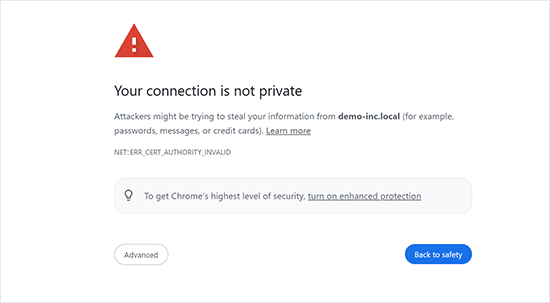
Teraz możesz się zastanawiać, dlaczego przeniesienie witryny WordPress z HTTP na HTTPS jest konieczne, zwłaszcza jeśli jest to prosty blog lub witryna małej firmy, która nie przetwarza płatności.
Dlaczego potrzebujesz HTTPS i SSL?
W 2018 roku Google ogłosiło inicjatywę mającą na celu zwiększenie bezpieczeństwa w sieci poprzez zachęcanie właścicieli witryn do przejścia z protokołu HTTP na HTTPS. W ramach obsługi tego ruchu przeglądarka Chrome zaczęła oznaczać wszystkie witryny bez certyfikatu SSL jako “Niezabezpieczone”.
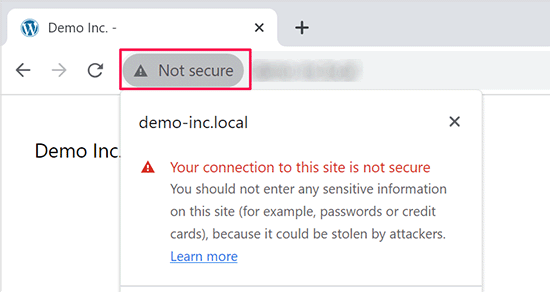
Google wspomniało również, że witryny z SSL otrzymają korzyści SEO i mogą osiągnąć wyższe rankingi wyszukiwania niż witryny niezabezpieczone. To ogłoszenie skłoniło wielu właścicieli witryn do przejścia na HTTPS.
Po wprowadzeniu ostrzeżenia “Niezabezpieczone” Chrome zaczął oznaczać witryny HTTP. Na przykład odwiedzenie witryny HTTP w trybie incognito lub wypełnienie formularza kontaktowego w witrynie HTTP uruchamia ostrzeżenie, oznaczając ją jako niezabezpieczoną.
Gdy odwiedzający zobaczą to ostrzeżenie, może to pozostawić negatywne wrażenie na temat witryny lub firmy.
Dlatego wszystkie strony internetowe muszą jak najszybciej przejść na HTTPS i zainstalować SSL.
Co więcej, SSL jest koniecznością, jeśli chcesz akceptować płatności online na swojej stronie e-handlu.
Dostawcy płatności tacy jak Stripe, PayPal Pro i Authorize.Net wymagają bezpiecznego połączenia płatniczego.
Zapewniamy, że nasze własne witryny używają SSL, w tym WPBeginner, OptinMonster, WPForms i MonsterInsights.
Wymagania dotyczące korzystania z HTTPS/SSL na witrynie WordPress
Wymagania dotyczące korzystania z SSL w WordPress nie są zbyt wysokie. Wszystko, co musisz zrobić, to kupić certyfikat SSL, a być może masz go już za darmo.
Najlepsze firmy hostingowe WordPress oferują darmowe certyfikaty SSL dla wszystkich swoich użytkowników:
Więcej szczegółów można znaleźć w naszym przewodniku na temat tego, jak uzyskać bezpłatny certyfikat SSL dla twojej witryny internetowej WordPress.
Jeśli Twoja firma hostingowa nie oferuje bezpłatnego certyfikatu SSL, musisz go zakupić.
Polecamy Domain.com, ponieważ oferuje najlepszą ofertę SSL dla zwykłych i wieloznacznych certyfikatów SSL.
Kupując u nich certyfikat SSL, otrzymujesz również pieczęć TrustLogo dla swojej witryny. Każdy certyfikat SSL objęty jest minimalną gwarancją bezpieczeństwa w wysokości 10 000 USD. Ceny zaczynają się od 33 USD rocznie, a certyfikaty SSL są odnaw iane automatycznie.
Po zakupie certyfikatu SSL należy poprosić dostawcę hostingu o jego zainstalowanie.
Potrzebujesz pomocy w konfiguracji SSL i przejściu na HTTPS?
Jeśli nie masz czasu na konfigurację SSL, nasza usługawsparcia Premium WordPress jest tutaj, aby pomóc! Możemy zająć się całym procesem za Ciebie, zapewniając, że Twoja witryna jest bezpieczna i gotowa dla odwiedzających.
- Opłata jednorazowa
- Szybki czas realizacji
- Dostępne na żądanie 24/7
Możesz spać spokojnie wiedząc, że Twoja witryna jest w rękach ekspertów. Skontaktuj się z nami już dziś, aby uzyskać bezproblemową instalację SSL i migrację HTTPS!
Konfiguracja WordPressa do korzystania z SSL i HTTPS
Po włączeniu certyfikatu SSL dla twojej domeny, będziesz musiał skonfigurować WordPressa tak, aby używał protokołów SSL i HTTP na twojej witrynie internetowej.
Pokażemy ci dwie metody, aby to zrobić i możesz wybrać tę, która najlepiej odpowiada twoim potrzebom.
Metoda 1: Konfiguracja SSL/HTTPS w WordPress przy użyciu wtyczki
Ta metoda jest łatwiejsza i zalecana dla początkujących.
Najpierw należy zainstalować i włączyć wtyczkę Really Simple SSL. Aby uzyskać więcej informacji, zobacz nasz przewodnik krok po kroku, jak zainstalować wtyczkę WordPress.
Po aktywacji należy odwiedzić stronę Ustawienia ” SSL. Wtyczka automatycznie wykryje certyfikat SSL i skonfiguruje witrynę WordPress do korzystania z protokołu HTTPS.
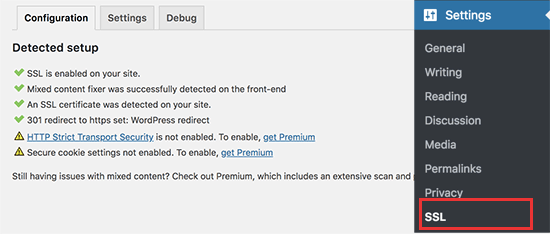
Wtyczka zajmie się wszystkim, w tym błędami związanymi z mieszaną treścią. Oto, co wtyczka robi za kulisami:
- Sprawdź certyfikat SSL
- Ustawienie WordPressa tak, by używał https w adresach URL
- Konfiguracjaprzekierowań z HTTP na HTTPS
- Poszukaj adresów URL w treści, które nadal są ładowane z niezabezpieczonych źródeł HTTP i spróbuj je poprawić.
Uwaga: Wtyczka próbuje poprawić błędy mieszanej zawartości przy użyciu techniki buforowania wyjściowego. Może to mieć negatywny wpływ na wydajność, ponieważ zastępuje zawartość witryny podczas ładowania strony. Wpływ ten jest widoczny tylko przy pierwszym ładowaniu strony i powinien być minimalny, jeśli używasz wtyczki buforującej.
Chociaż wtyczka mówi, że możesz zachować SSL i bezpiecznie wyłączać wtyczkę, nie jest to w 100% prawdą. Będziesz musiał pozostawić wtyczkę aktywną przez cały czas, ponieważ wyłączanie wtyczki spowoduje powrót błędów mieszanej treści. Więcej szczegółów można znaleźć w naszej recenzji Really Simple SSL.
Metoda 2: Ręczna konfiguracja SSL/HTTPS w WordPress
Ta metoda wymaga ręcznego rozwiązywania problemów i edytowania plików WordPress. Jest to jednak trwałe i bardziej zoptymalizowane pod kątem wydajności rozwiązanie, z którego korzystamy na WPBeginner.
Jeśli uważasz, że ta metoda jest trudna, powinieneś zatrudnić programistę WordPress lub skorzystać z pierwszej metody.
W ramach tej metody może być konieczna edycja motywu WordPress i plików kodu. Jeśli nie robiłeś tego wcześniej, zapoznaj się z naszym przewodnikiem na temat kopiowania i wklejania fragmentów kodu w WordPress.
Najpierw musisz odwiedzić stronę Ustawienia ” Ogólne. W tym miejscu należy zaktualizować pola adresu URL WordPress i witryny, zastępując http na https.
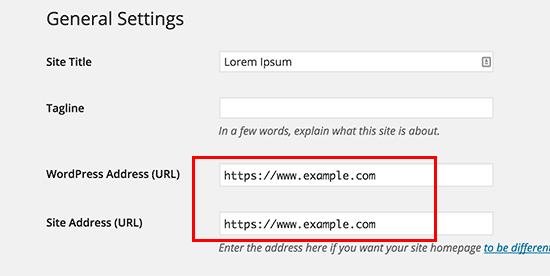
Nie zapomnij kliknąć przycisku “Zapisz zmiany”, aby zapisać twoje ustawienia.
Po zapisaniu ustawień WordPress wyloguje cię i zostaniesz poproszony o ponowne zalogowanie.
Następnie musisz skonfigurować przekierowania WordPress z HTTP na HTTPS, dodając następujący kod do twojego pliku .htaccess:
1 2 3 4 5 | <IfModule mod_rewrite.c>RewriteEngine OnRewriteCond %{HTTPS} offRewriteRule ^(.*)$ https://%{HTTP_HOST}%{REQUEST_URI} [L,R=301]</IfModule> |
Jeśli korzystasz z serwerów NGINX, będziesz musiał dodać następujący kod, aby przekierować z HTTP na HTTPS w twoim pliku konfiguracyjnym:
1 2 3 4 5 | server {listen 80;server_name example.com www.example.com;return 301 https://example.com$request_uri;} |
Nie zapomnij zastąpić example.com nazwą twojej domeny.
Wykonując te kroki, unikniesz błędu WordPress HTTPS nie działa, ponieważ WordPress będzie teraz wczytywać całą twoją witrynę internetową za pomocą HTTPS.
Jeśli chcesz wymusić SSL i HTTPS na twoim obszarze administracyjnym WordPress lub stronach logowania, musisz skonfigurować SSL w pliku wp-config.php.
Dodaj następujący kod nad linią “To wszystko, przestań edytować!” w twoim pliku wp-config.php:
1 | define('FORCE_SSL_ADMIN', true); |
Ta linia pozwala WordPressowi wymusić SSL / HTTP w obszarze administracyjnym WordPress. Działa również w sieciach witryn WordPress.
Gdy to zrobisz, twoja witryna internetowa jest w pełni skonfigurowana do korzystania z SSL / HTTPS, ale nadal będziesz napotykać błędy mieszanej treści.
Błędy te są powodowane przez źródła (obrazki, skrypty lub arkusze stylów), które nadal są wczytywane przy użyciu niezabezpieczonego protokołu HTTP w adresach URL. W takim przypadku na pasku adresu twojej witryny internetowej nie będzie widoczna ikonka zabezpieczenia w postaci kłódki.
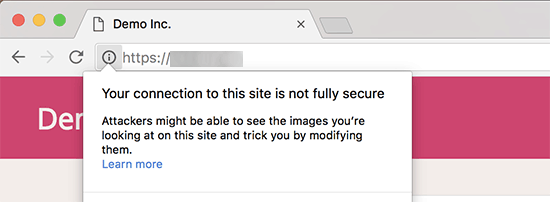
Wiele nowoczesnych przeglądarek automatycznie blokuje niebezpieczne skrypty i zasoby.
Możesz zobaczyć ikonkę kłódki, ale z powiadomieniem o tym w pasku adresu twojej przeglądarki.
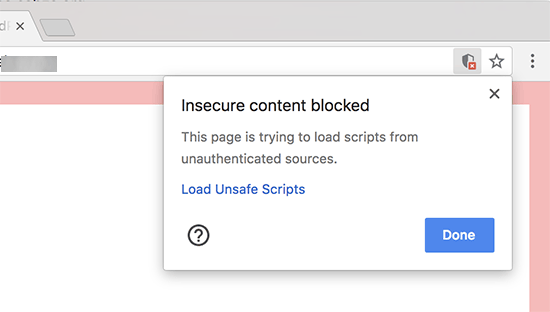
Za pomocą narzędzia Inspect można sprawdzić, które treści są serwowane za pośrednictwem niezabezpieczonego protokołu.
Błąd mieszanej treści zostanie wyświetlony jako ostrzeżenie w konsoli ze szczegółowymi informacjami dla każdego elementu mieszanej treści.
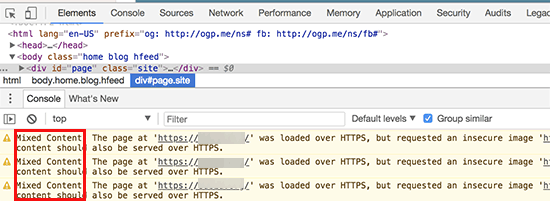
Zauważysz, że większość adresów URL to obrazki, ramki iframe i galerie obrazów, podczas gdy niektóre to skrypty i arkusze stylów wczytywane przez twoje wtyczki i motywy WordPress.
Poprawka mieszanych treści w bazie danych WordPressa
Większość nieprawidłowych adresów URL to obrazy, pliki, elementy osadzone i inne dane przechowywane w bazie danych WordPress. Poprawmy je w pierwszej kolejności.
Najlepiej byłoby znaleźć wszystkie wzmianki o adresie URL starej witryny w bazie danych, które zaczynają się od HTTP i zastąpić je nowym adresem URL witryny, który zaczyna się od HTTPS.
Możesz to łatwo zrobić, instalując i włączając wtyczkę Search & Replace Everything. Aby uzyskać więcej informacji, zapoznaj się z naszym przewodnikiem krok po kroku, jak zainstalować wtyczkę WordPress.
Po włączaniu należy przejść na stronę Narzędzia ” WP Wyszukaj i zamień. W polu “Szukaj” należy dodać adres URL Twojej witryny internetowej z http. Następnie w polu “Zamień” dodaj adres URL Twojej witryny internetowej z https.
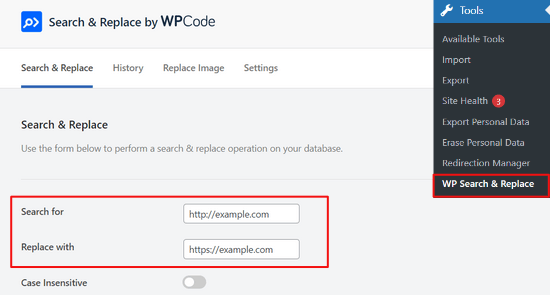
Poniżej znajdują się wszystkie tabele bazy danych WordPress.
Musisz wybrać wszystkie z nich, aby przeprowadzić dokładną kontrolę.
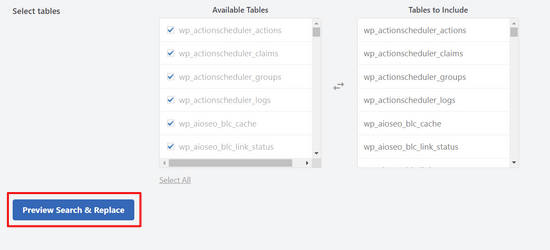
Następnie kliknij przycisk “Podgląd wyszukiwania i zamiany”, aby zobaczyć wszystkie zmiany wprowadzone przez wtyczkę.
Na koniec kliknij przycisk “Zamień wszystko”.
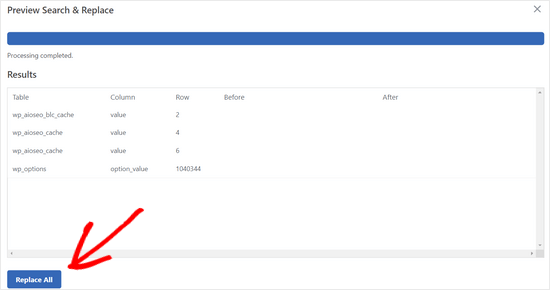
Wtyczka przeszuka teraz twoją bazę danych WordPress pod kątem adresów URL zaczynających się od http i zastąpi je bezpiecznymi adresami URL https. Może to chwilę potrwać, w zależności od rozmiaru twojej bazy danych WordPress.
Poprawka błędów mieszanych treści w motywie WordPress
Innym częstym winowajcą powodującym błędy mieszania treści jest twój motyw WordPress. Każdy przyzwoity motyw WordPress zgodny ze standardami kodowania WordPress nie spowoduje tego problemu.
Po pierwsze, będziesz musiał użyć narzędzia Inspect twojej przeglądarki, aby znaleźć zasoby i miejsce, z którego są wczytywane.
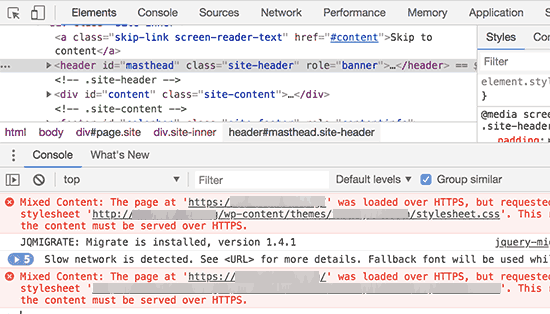
Następnie musisz znaleźć je w twoim motywie WordPress i zastąpić je https. Będzie to trochę trudne dla większości początkujących, ponieważ nie będziesz w stanie zobaczyć, które pliki motywu zawierają te adresy URL.
Poprawka błędów mieszanych treści spowodowanych przez wtyczki
Niektóre zasoby o mieszanej treści będą wczytywane przez wtyczki WordPress. Każda wtyczka WordPress zgodna ze standardami kodowania WordPress nie spowoduje błędów mieszanej treści.
Nie zalecamy edytowania plików wtyczek WordPress. Zamiast tego należy skontaktować się z autorem wtyczki i poinformować go o tym. Jeśli nie odpowiedzą lub nie będą w stanie tego poprawić, powinieneś znaleźć odpowiednią alternatywę.
Uwaga: Jeśli z jakiegoś powodu nadal napotykasz błąd mieszanej treści, zalecamy tymczasowe korzystanie z wtyczki Really Simple SSL, aby nie wpływać na użytkowników, podczas gdy poprawisz problem na witrynie przejściowej lub zatrudnisz programistę.
Prześlij swoją witrynę HTTPS do Google Search Console
Wyszukiwarki takie jak Google uważają https i http za dwie różne witryny internetowe. Aby uniknąć problemów z SEO, musisz poinformować Google, że Twoja witryna internetowa została przeniesiona.
Aby to zrobić, wystarczy przejść do konta Google Search Console i kliknąć przycisk “Dodaj właściwość”.

Spowoduje to wyświetlenie wyskakującego okienka, w którym należy utworzyć nowy adres https twojej witryny internetowej.
Istnieją dwie metody weryfikacji witryny: nazwa domeny lub prefiks adresu URL. Zalecamy metodę prefiksu adresu URL, ponieważ jest ona bardziej elastyczna.
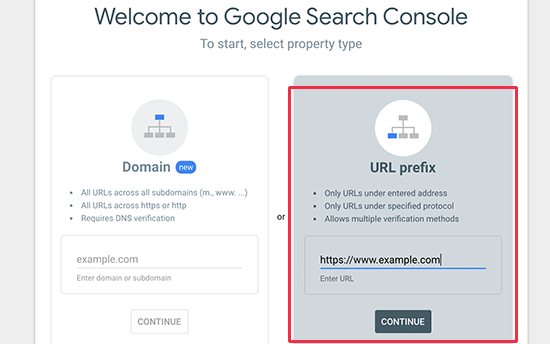
Następnie Google poprosi Cię o zweryfikowanie własności Twojej witryny internetowej.
Można to zrobić na kilka sposobów. Wybierz dowolną metodę, a otrzymasz instrukcje dotyczące weryfikacji twojej witryny. Zalecamy skorzystanie z metody tagów HTML.
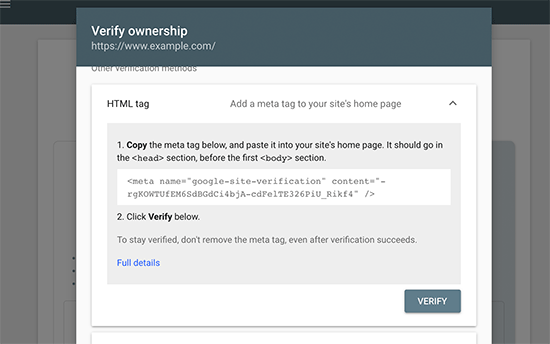
Zobaczysz teraz fragment kodu HTML, który musisz dodać do sekcji head twojej witryny internetowej WordPress.
Dodawanie kodu weryfikacyjnego Search Console za pomocą All in One SEO
Najpierw zainstaluj i włącz wtyczkę All in One SEO for WordPress. Aby uzyskać więcej informacji, zapoznaj się z naszym poradnikiem na temat instalacji wtyczki WordPress.
Uwaga: Istnieje również darmowa wersja All in One SEO, którą można wypróbować.
Po włączaniu przejdź do strony All in One SEO ” Ustawienia ogólne i kliknij Google Search Console.
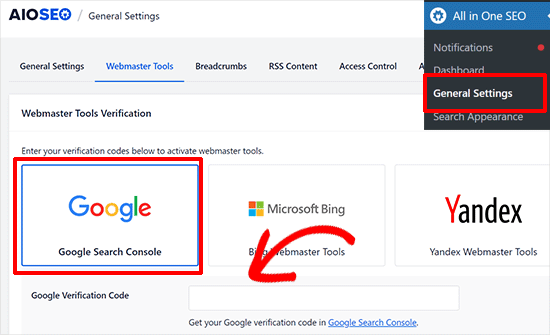
Poniżej należy dodać kod weryfikacyjny skopiowany wcześniej z witryny internetowej Google Search Console.
Nie zapomnij kliknąć przycisku “Zapisz zmiany”, aby zapisać twoje ustawienia.
Następnie przełącz się z powrotem na kartę Google Search Console i kliknij przycisk “Weryfikuj”.
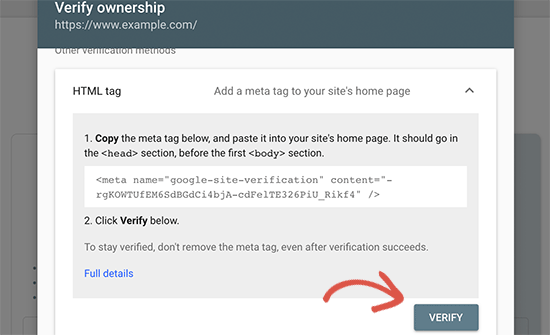
Gdy twoja witryna zostanie zweryfikowana, Google wyświetli tutaj raporty Search Console.
Musisz również upewnić się, że zarówno wersja https, jak i http są dodane do twojej Search Console.
W ten sposób informujesz Google, że chcesz, aby wersja https Twojej witryny była traktowana jako wersja podstawowa. W połączeniu z przekierowaniami 301 skonfigurowanymi wcześniej, Google przeniesie rankingi wyszukiwania do wersji https Twojej witryny i najprawdopodobniej zobaczysz poprawę w rankingach wyszukiwania.
Zasoby bonusowe
Poniżej znajduje się kilka dodatkowych zasobów, które mogą pomóc w samodzielnej poprawie typowych problemów z WordPressem i dowiedzieć się więcej o WordPressie:
- Jak naprawić typowe problemy z SSL w WordPress (przewodnik dla początkujących)
- Najczęstsze błędy WordPressa i sposoby ich poprawki
- TLS vs SSL: Którego protokołu należy używać w WordPress?
- Jak naprawiono błąd bezpiecznego połączenia w WordPress?
Film instruktażowy
Mamy nadzieję, że ten artykuł pomógł Ci dodać HTTPS i SSL w WordPress. Możesz również zapoznać się z naszym kompletnym przewodnikiem bezpieczeństwa WordPress z instrukcjami krok po kroku, jak zapewnić bezpieczeństwo witryny WordPress lub jak odnowić certyfikat SSL.
If you liked this article, then please subscribe to our YouTube Channel for WordPress video tutorials. You can also find us on Twitter and Facebook.





Raul
Hi,
I’m in a predicament due to lack of knowledge and Google. My website is currently ranked # 2 in Google for a particular organic keyword. I ordered a SSL from my hosting company and I received confirmation that the SSL is ready to be used. I would like to use the SSL on every page in my site including the shopping cart but I don’t want to lose the #2 ranking in Google by not converting to SSL properly. Your advice will be appreciated.
Raul
Jonathon Fowler
Hi there,
Great article. One question, I read that using a wildcard redirect will have a negative impact on SEO – is this correct? The articel says ranking will drop using a wildcard redirect.
I have thousands if images on my site using http in the url…using yur redirect would direct all images to the new https?
Thanks !
WPBeginner Support
No, the whole purpose of redirects is to help with SEO and avoid negative impact of changed URLs. This is the method recommended by search engines themselves.
Admin
dylan
Hi,
I love your site – lots of good stuff here.
I’m wondering if you can recommend a wordpress security plug-in that you know for sure plays friendly (without too much hassle) with full site SSL / HTTPS.
My site is covered already (every page) but I’m worried about installing a plug-in that may interfere.
Any suggestions would be much appreciated.
Cheers
WPBeginner Support
We use Sucuri on WPBeginner and all other websites that we manage.
Admin
turan
Thank you very much everything solved by adding above code to .htaccess file
Joe
Will changing the Site URL in WordPress to “HTTPS” auto redirect any HTTP requests?
We don’t need htaccess rewrites if the SITE URL is HTTPS?
Cristi Scutaru
Great post, it helped me switch my WordPress site to SSL in just a few minutes!
Great site as well, congrats for such a valuable content. I found myself often googling for some WordPress related answers for the past few days, and your pages came on top frequently, with clear and concise solutions.
WPBeginner Support
Thanks, glad you found it helpful.
Admin
Piet
When only switching the WP backend to SSL, the next challenge is how to show featured images in the backend? These are loaded via http instead of https and as such do not show in the WP backend anymore.
Is there a way to load them from https for the backend only or do I just have to accept the fact that I will not be able to see them (in the backend)?
Tushar
Good article. Why don’t you use https on WPBegineer?
WPBeginner Support
We don’t use it right now but may be in future.
Admin
Yuvraj Khavad
Hi Team wpbeginner,
Thanks for this post. You save my time.
Keep Good Work.
Thanks
Yuvraj R K.
Logan
Thanks for this great guide to setting up https. Was using the plugin your mentioned for a long time but it caused problems with my site so I only used it to secure my admin panel. Now I can cover my entire site.
Felix Figueroa
The .htaccess edit broke my site with the “ERR_TOO_MANY_REDIRECTS” message. Tried suggestions detailed in this post. After disabling all plugins i get a 500 Server Error. Thanks, my site is completely broken now.
Eivind F Skjellum
Thanks, very helpful. Got my ssl working thanks to you!
Eivind
beamkiller
Dear wpBeginner,
I have made the modifications in htaccess and Options too but I got error in Chrome:
ERR_TOO_MANY_REDIRECTS
So my page is not secured with SSL, on Checkout and My-Account it is working with WooCommerce. But I cannot get to work it on the whole WP installation.
MMPrint
Hope this helps:
Uncheck the WooCommerce “Un-force HTTPS when leaving the checkout” setting.
The htaccess if forcing https but then woocommerce forces http so they just go back and forth in a loop.
Chetan
Hi MMPrint
I can give thousand thumbs up to your answer. This has solved my issue which i was living with since the last 10 days. No matter what i tried in the .htaccess file the site wasnt showing up. I also played with deactivating the plugins etc etc. Finally it was woocommerce which was the culprit.
Thanks a lot man !
Cheers
Chetan
Kevin Verlinden
I like this site the information is very useful and comprehensive. It has helped me already a lot of times.
Austin
Hey – any reason SSL is not being used on Optinmonster etc like mentioned in the article?
WPBeginner Support
SSL is used on OptinMonster website when users login or signup.
Admin
Austin
“We already use SSL for our eCommerce sites like OptinMonster, Soliloquy, and Envira Gallery.”
I took this to mean all of the pages – wondering if that was the case and now for some reason it has been reverted to non-SSL?
Thanks!
Armando Landois
I followed this guide and now my domain is working at
George
I tried this plugin and it broke my site. Uninstalled in immediately. I still need what this plugin offered, which is https on some pages, but not the whole site. Is there any other plugin (other than this one, which hasn’t been updated in over two years) that can do this?
Patrick
The free version of iThemes Security will take care of this for you
Celeste
What do you mean, Patrick, that iThemes Security will take care of this. I just went to their website and it seems like a good plugin for enhanced security. But I didn’t see any reference to SSL or setting up specific pages to use SSL only.
Octavio Cestari
I did the installation of a plugin which forced all the site enter https, now I can no longer access the site or the wordpress dashboard, how do I reverse the process?
Drew
I just added the code using your .htaccess solution. Worked perfectly and exactly as described. A big thank you!
michael s
You say all you need to do is buy a certificate, but my hosting service requires a static IP address also which is WAY more expensive than a basic certificate. My service wants $4/month for static IP.
DJ
HELP!
I did this change and now I can’t access my site through WP-ADMIN
It is stating my site is down. I don;t have an .htaccess file in my files. I have set FileZilla to show hidden files and cannot find it. Can you help me get back into my site?
Thanks.
WPBeginner Support
First try to deactivate all your plugins this should resolve your issue, but if it doesn’t then see our guide
Admin
DJ
I cannot get in to deactivate any plugins.
DJ
What Guide?
DJ
OK, added the htaccess file and added the code you have above but I still cannot get in.
Any ideas? All I’m seeing is a message saying my site does not exist.
DJ
David Coombes
DJ
Not sure if you are still having an issue but if you google ‘a plugin broke my site’ or something similar then there’s some good answers – basically it involved removing the plugins folder which should get your site back then reactivating the plugins one by one.
Hope it helps – it’s frustrating when a site goes down.
Sasha
I used the .htaccess method and got this error:
“The page isn’t redirecting properly
Firefox has detected that the server is redirecting the request for this address in a way that will never complete.
This problem can sometimes be caused by disabling or refusing to accept cookies.”
Any one has an idea?
thanks
Mike S
I added the code into the .htaccess and I got the following issue:
The page isn’t redirecting properly
Firefox has detected that the server is redirecting the request for this address in a way that will never complete.
This problem can sometimes be caused by disabling or refusing to accept cookies.
Marych
PLEASE HELP
I didn t get a certificate but just went to settings > General and replaced http by https .
after updating I can t access to my wordpress url and the message ‘ Your connection is not private
Attackers might be trying to steal your information from etlco.com.sa (for example, passwords, messages, or credit cards). ‘ is displayed .
Any solution , please help me
Andron
You need to get a certificate in order for it to work. When you request a page over https, it starts a conversation between your browser and the server in which the server validates its identity as the correct site. That validation occurs by sending a trusted certificate to your browser. If a certificate doesn’t exist, your browser will give you that “connection is not private” warning. It’s done to protect you from sites that aren’t who they claim to be.
Namecheap offers basic SSL certificates for $9 a year, and there are plenty of other options. If you can wait, look into LetsEncrypt.org — they’ll be offering free ones starting this September, I think.
sewe herbert
Hi Marych, just had that same problem, but managed to fix it; here is how
use an FTP Program, alocate the wp-config.php
then put this just after (define(‘ABSPATH’, dirname(__FILE__) . ‘/’);)
define(‘WP_HOME’,’http://yoursite.com’);
define(‘WP_SITEURL’,’http://yoursite.com’);
then save and re-upload the wp-config.php file
Then all is well
Gary Morrison
We have did like you said .. and not we are locked out of the dashboard and any page we go to on front end will not display only home page works.
Thank you for your time ..
P.S. and now my images are not showing up…
WPBeginner Support
Please retry all the steps in the article again. If the problem persists contact your web hosting service provider.
Admin
Gary Morrison
There was a problem on Hosting side with the migration to SSL server..
All is good TY
Tom L
Thank you very much for your support. I was able to install the plugin and have my site with all pages https without any adjustments.
Perfect instructions.
Tecnologia Geek
nice..is working now..how i make this to show the green bar?
Tecnologia Geek
can i have some help here.. i dit all this step but..the site look diferent and i cant login to admin..
Maarten
It is worth mentioning this technique breaks WooCommerce downloads. It will end in a 403 access denied for forced download or x-sendfile downloadable products.
Matthew
Thanks for the excellent article.
I was under the impression that installing an SSL certificate was as simple as you have indicated… however, when I installed mine it appears to confused (and completely broken) my site. I am being told that some parts of my wordpress database have changed to https, but others haven’t.
Now I can’t get in to the wordpress admin area at all – but I can ftp to the hosting.
Any ideas how I can update my wordpress databases and themes to reflect https rather than http ?
I am tempted to uninstall the certificate, restore my entire site from a backup and wander off, shaking my head in frustration.
Thanks,
Matthew
Shane
Your article made no mention of verifying plugin compatibility with SSL before making the change. Is that because plugin code generally doesn’t go “offsite” and hence result in “insecure” content warnings, or are plugins something that we should be concerned about and carefully review before considering the switch?
Jim R
thank you for this- never used SSL or HTTPS before and suddenly needed a java donations page to be HTTPS. with your instructions I was able to get it working in a matter of minutes.
Jennifer Goddard
Don’t download this plug in. As of late 2014 there are multiple complaints of incompatibility!
GJ
Thanks for the tutorial.
I wanted to add a few more resources..
1) Change all the ur’s media/js etc through the Bluevelvet plugin from http to https
2) if you do not have the green https color you can look for insecure files at whynopadlock.com
3) Submit your https version to the webmaster tools as well
Kevin Donnigan (@anythinggraphic)
Very good additional tips. Appreciate it.
Amr
Ahh All what i needed bro you’re the man!
Ollie
Excellent tips as always.
I’d like to point out for anyone using the .htaccess redirect, to include that in their htacces file first at the top. I had the usual wordpress htaccess code at the top of the file and it wasn’t working until I pasted the new code before it.
Johny P
Really now a days ssl is moving to a new level . Awesome article.
Rael
hi guys,
I have an http link which cannot be changed using //www.url.com/ because the server it’s on doesn’t have SSL.
The issue comes when this link appears on a secure page on my site.
Is there a way to redirect it to http once off the https page?
WPBeginner Staff
Contact W3 Total Cache support.
Muhammad Umer
Hi Syed i really need your help in this, some plugin causing this i added this today more than 5 times after few time it remove automatically from htaccess file, i am using w3 total cache.
Muhammad Umer
Hi, Thank you for the guide i configured everything perfectly with your guide, but when i empty cache or use w3 total cach plugn they removed my .htaccess file and start their own.
is there any settings in the plugin?
currently want to use ssl on
Thanks,
WPBeginner Staff
Yes, we do.
Mark
Hi, the WordPress HTTPS plugin hasn’t been updated in a couple of years. Do you still recommend it?
WPBeginner Staff
Your site is making http requests to resources which are not secure. For example many WordPress themes fetch Google fonts using a non-https url. View your site’s source code to figure out which scripts, images, stylesheets are using non-https URLs.
Dustin
Very helpful. SSL works great on my sites now. The main issue I ran into was securing images. Easy to identify, but time-consuming to fix. It seems all I had to do was reload the same image and it fixed the problem. For sites that have hundreds or more images, is there a plugin or an easier way you’d recommend to fix insecure images? Thank you.
Gavin
Like Justin, the biggest issue I had was with images. I’m currently running SSL Insecure Content Fixer plugin with the ‘Content’ option checked to resolve this issue, but it’s unsatisfactory to have to have a plugin activated all the time instead of just being able to apply a change from http to https to images across the board (perhaps other media types too? – I haven’t check this). Is there a way to apply a universal permanent change? Thanks.
Travis Pflanz
One of the biggest culprits of elements not being loaded over HTTPS is a theme calling Google Fonts. Unfortunately, many theme developers call the Google font with http://, rather than just //
WPBeginner Staff
Seems like your website has some elements loaded from a non secure URL. Most probably a third party script or stylesheet.
Heri Saputra
Hi.. I have been installed comodo ssl to my site but ssl on my site is not green light, how I can fix it?
Heri Saputra
Hi,,, I have been installed ssl to my website but my ssl is not green light but like this, how I can fix it? Tx
WPBeginner Staff
We will be moving all our sites to SSL and HTTPs very soon.
Matthew Bochnak
Thanks for posting this! I had to go through this process and could not figure out the redirect from http to https.
Techno-Proo.com
why you don’t use SSL and HTTPS ?